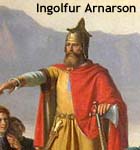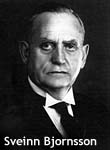 It is suggested that the first permanent settler was Ingolfur Arnarson who arrived in 874 fromNorway, and resided in present day Reykjavík.
It is suggested that the first permanent settler was Ingolfur Arnarson who arrived in 874 fromNorway, and resided in present day Reykjavík. He was quickly followed by more settlers from Norway, as well asIreland, and by the mid-900's most of Iceland's cultivable land had been snatched up.
The early settlers put together a council to moderate the area which lasted until 1262, at which point the legislation became incapable of being able to deal with the increasing power.
Around 1380 control of Iceland was passed along toDenmark, and the two were united along with Norway andSweden as the Kalmar Union for the next several hundred years.
Life was less than forgiving for the people of Iceland, as they not only battled arid land conditions and a rough climate, but were also the poorest European country.
To further add to their troubles, the Black Death plague hit Iceland hard in the early 1400's, and over 50% of the population succumbed to the disease.
The next 400 years continued along the same lines, with various pirate raids along the coast, and then the smallpox epidemic and Laki volcanic eruption in the late 18th century.
The Napoleonic Wars of 1814 broke Denmark and Norwayinto two kingdoms, however Iceland stayed under Danish rule until 1944.
Prior to their independence, Iceland proclaimed neutrality during World War II along with Denmark.
Despite their neutral state, on April 9, 1940, German forces occupied Denmark, and Iceland took control of Denmark's foreign affairs.
But it wasn't long before Iceland found their own country taken over after the British Armed Iceland Forces occupied the island a month later, only to be replaced by the United States in 1941.
 As the war came to an end, Iceland regained control of their country, and Sveinn Bjornsson was elected the first president of Iceland. On March 30, 1949, in the midst of a domestic controversy, Iceland became a member of NATO.
As the war came to an end, Iceland regained control of their country, and Sveinn Bjornsson was elected the first president of Iceland. On March 30, 1949, in the midst of a domestic controversy, Iceland became a member of NATO. The United States returned to Iceland in May of 1951, after the signing of a defense agreement, and lingered through the Cold War.
Post-war, Iceland's economy thrived due in part to the fishing industry and the Marshall Plan (an Americanprogram instilled to rebuild European economies and prevent Soviet communism from spreading).
For many decades Iceland enjoyed a strong economy with low unemployment, low inflation, and a per capita income among the highest in the world. Unfortunately, due to the 2009 worldwide economic collapse, Iceland still suffers through a severe financial crisis. Despite that, it remains an alluring place for travelers to visit.
On March 21, 2010, the Eyjafjallajökull Volcano in southern Iceland erupted for the first time since 1821, forcing 600 people to flee their homes. Further eruptions in April forced hundreds of people to abandon their homes. And in fact, the resultant cloud of volcanic ash brought major disruption to air travels across Europe.
No comments:
Post a Comment